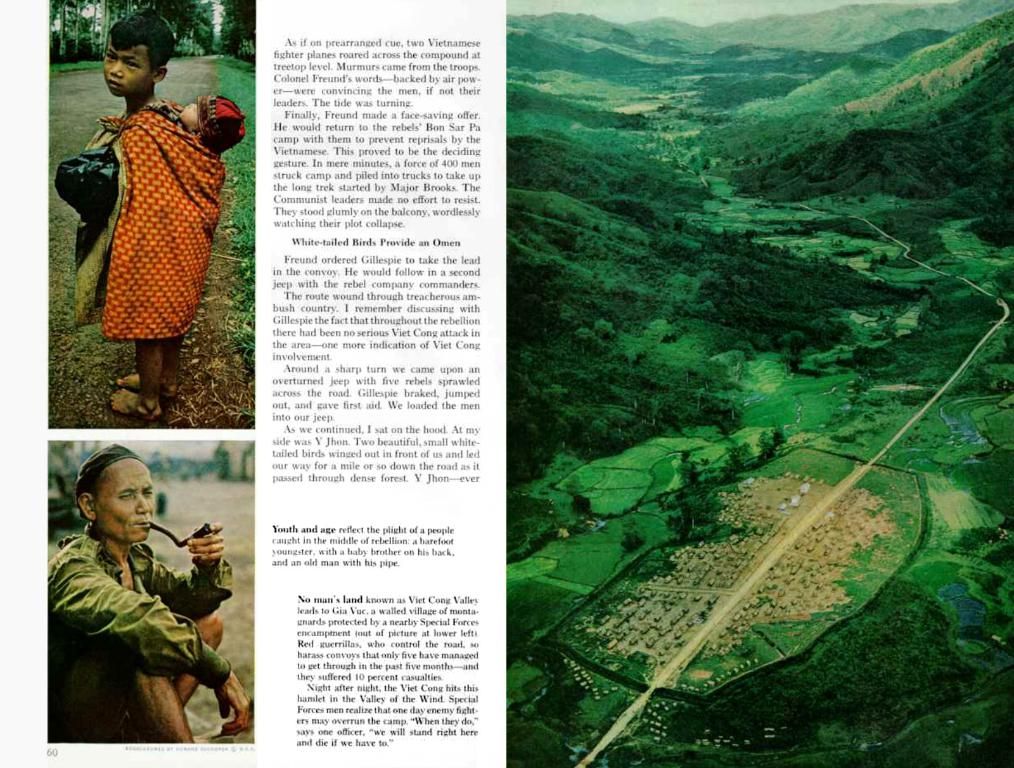Top Knots for Crafting Bushcraft Shelters and Camp Arrangements
In the wilderness, knowing the right knots is a crucial skill for setting up sturdy, weather-resistant campsites and bushcraft shelters. These knots are the silent heroes, securing gear and creating stable structures day after day. Wet, cold, or arduous conditions won't faze you when you've got these knots under your belt.
So, what's a good bushcraft knot you ask? It's one that's strong, easy to tie and untie, even after taking strain, and versatile enough to tackle a variety of scenarios. Fear not, in this guide we'll dish out the essential knots to kickstart your bushcraft journey or bolster your outdoor resume.
Essential Knots for a Wilderness Shelter
1. Bowline Knot
- Tied like a noose, this knot will never slip, making it an ideal choice for securing tarps and lines. Known to many as the 'rescue knot', its reliability shines when it's time to tighten the screws.
Usage: Create a sturdy anchor point, be it tying off one end of a tarp or securing a rope to a tree.
Bowline
2. Taut-Line Hitch
Fixed loop
- Your go-to for setting up guy lines. Adjustable and tension-controlled, this bad boy is perfect for keeping tension in tents or tarps as conditions change.
Easy
Usage: Guy lines and setting tension between two points, be it securing your shelter from gusty winds or ensuring that tarp stays taut.
High
3. Clove Hitch
Low
- A simple, straightforward knot best used for quick and temporary restraints. It's an excellent choice for anchoring ropes quickly, although it should be avoided for high-strength, long-lasting applications.
Usage: Creating temporary holds or anchoring ropes rapidly for an instant setup.
Taut-Line Hitch
4. Prusik Knot
Adjustable tension
- Often used in climbing, the Prusik knot is incredibly handy in bushcraft, providing an adjustable loop on a rope. Ideal for setting up shelters and ridgelines.
Moderate
Usage: Setting up lines between trees, providing the needed tension on ridgelines, or for securing tarp edges.
Medium
Getting Crafty Instead of Turning to Other Fasteners
Medium
Why bother with knots? They're lightweight, rust-free, and eliminates the need for additional tools. Mastering a few versatile knots means less items to lug around and reduced anxiety about tools breaking. It's also a handy skill for adapting to unpredictable scenarios, whether it's a sudden weather change or finding yourself short on supplies.
Knots to Know for a Snug Camp Setup
Clove Hitch
1. Trucker's Hitch
Temporary holds
- Craving that tension in your lines? The trucker's hitch is your best friend. Great for tying down loads in camp and setting up tight tarp lines.
Easy
Usage: Make high-tension lines for your camp setup or securely fix a tarp.
Medium
2. Square Knot
High
- Easy to tie, the square knot is perfect for joining two ropes of equal diameter or bundling gear. Although not suitable for bearing heavy loads, it's excellent for lighter-duty connections.
Usage: Securely bundle gear together or join two lines in camp.
Prusik
Knowing Your Knots
Adjustable loop
Each knot has its place; choosing the right one depends on the gear, conditions, and setup at hand. Knot knowledge can send your bushcraft skills soaring.
Moderate
Advanced Knots to Explore
High
Savor the adventure of bushcraft by mastering more knots.
Low
1. Sheet Bend
- A fantastic knot for joining two ropes, regardless of diameter. It creates a strong connection for extending lines or joining rope segments for bigger shelters.
Trucker's Hitch
Usage: Joining two ropes together and creating a stronger connection.
High tension
2. Fisherman's Knot
Moderate
- Used in fishing, but just as useful in bushcraft for securing lines, it creates a strong connection for ropes of similar thickness.
High
Usage: Securely join two ropes together.
Low
3. Double Fisherman's Knot
- Double up for extra security and strength in your lines. Perfect for creating robust ties in various situations.
Usage: Joint two ropes and ensure a robust and secure connection.
In the wilderness, the Bowline Knot, Taut-Line Hitch, Clove Hitch, and Prusik Knot are essential for setting up sturdy, weather-resistant campsites and bushcraft shelters. The Bowline Knot, with its noose design, provides a secure anchor point, making it ideal for securing tarps and lines. The Taut-Line Hitch is adjustable and perfect for setting up Guy lines, helping keep tension in tents or tarps as conditions change. The Clove Hitch is simple and best used for quick, temporary restraints, while the Prusik Knot offers an adjustable loop on a rope, great for setting up shelters and ridgelines. Knowing knots is beneficial as they are lightweight, rust-free, and eliminate the need for additional tools, making bushcraft skills more adaptable to unpredictable scenarios.
Other useful knots for a snug camp setup include the Trucker's Hitch for making high-tension lines in camp, the Square Knot for securing gear or joining two lines, and the Sheet Bend for joining two ropes, regardless of diameter. Mastering these knots can help minimize the items to lug around in the outdoors, improve the outdoor lifestyle, and enhance the education and self-development of bushcrafters.
More advanced knots to explore include the Sheet Bend, Fisherman's Knot, and Double Fisherman's Knot, which provide additional strength and security in various bushcraft situations. These knots can add to the fashion-and-beauty aspect of bushcraft, as well as the home-and-garden aesthetic, by creating intricate patterns and designs with rope. They can also contribute to the travel experience by enabling bushcrafters to build shelter in remote locations and navigate rocky terrains with confidence. Knowing these knots can send bushcraft skills soaring and open up opportunities for exploring further in the wilderness, food-and-drink experiences, and sports activities.







